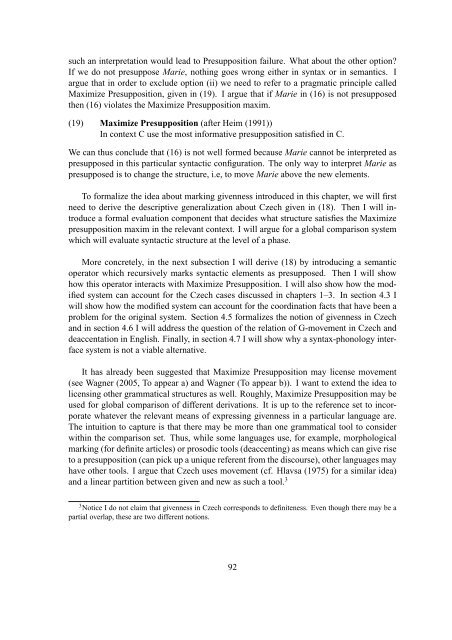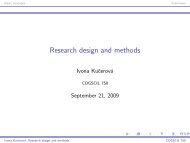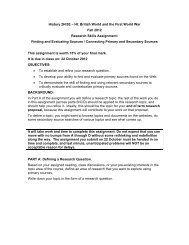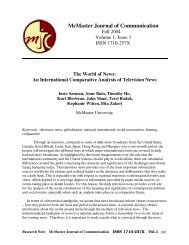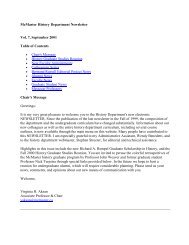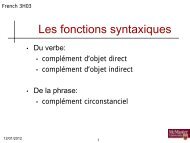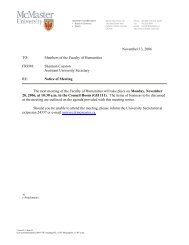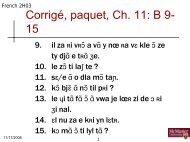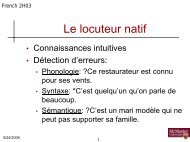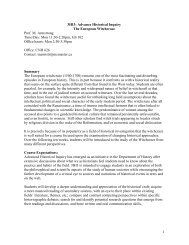The Syntax of Givenness Ivona Kucerová
The Syntax of Givenness Ivona Kucerová
The Syntax of Givenness Ivona Kucerová
Create successful ePaper yourself
Turn your PDF publications into a flip-book with our unique Google optimized e-Paper software.
such an interpretation would lead to Presupposition failure. What about the other option?<br />
If we do not presuppose Marie, nothing goes wrong either in syntax or in semantics. I<br />
argue that in order to exclude option (ii) we need to refer to a pragmatic principle called<br />
Maximize Presupposition, given in (19). I argue that if Marie in (16) is not presupposed<br />
then (16) violates the Maximize Presupposition maxim.<br />
(19) Maximize Presupposition (after Heim (1991))<br />
In context C use the most informative presupposition satisfied in C.<br />
We can thus conclude that (16) is not well formed because Marie cannot be interpreted as<br />
presupposed in this particular syntactic configuration. <strong>The</strong> only way to interpret Marie as<br />
presupposed is to change the structure, i.e, to move Marie above the new elements.<br />
To formalize the idea about marking givenness introduced in this chapter, we will first<br />
need to derive the descriptive generalization about Czech given in (18). <strong>The</strong>n I will introduce<br />
a formal evaluation component that decides what structure satisfies the Maximize<br />
presupposition maxim in the relevant context. I will argue for a global comparison system<br />
which will evaluate syntactic structure at the level <strong>of</strong> a phase.<br />
More concretely, in the next subsection I will derive (18) by introducing a semantic<br />
operator which recursively marks syntactic elements as presupposed. <strong>The</strong>n I will show<br />
how this operator interacts with Maximize Presupposition. I will also show how the modified<br />
system can account for the Czech cases discussed in chapters 1–3. In section 4.3 I<br />
will show how the modified system can account for the coordination facts that have been a<br />
problem for the original system. Section 4.5 formalizes the notion <strong>of</strong> givenness in Czech<br />
and in section 4.6 I will address the question <strong>of</strong> the relation <strong>of</strong> G-movement in Czech and<br />
deaccentation in English. Finally, in section 4.7 I will show why a syntax-phonology interface<br />
system is not a viable alternative.<br />
It has already been suggested that Maximize Presupposition may license movement<br />
(see Wagner (2005, To appear a) and Wagner (To appear b)). I want to extend the idea to<br />
licensing other grammatical structures as well. Roughly, Maximize Presupposition may be<br />
used for global comparison <strong>of</strong> different derivations. It is up to the reference set to incorporate<br />
whatever the relevant means <strong>of</strong> expressing givenness in a particular language are.<br />
<strong>The</strong> intuition to capture is that there may be more than one grammatical tool to consider<br />
within the comparison set. Thus, while some languages use, for example, morphological<br />
marking (for definite articles) or prosodic tools (deaccenting) as means which can give rise<br />
to a presupposition (can pick up a unique referent from the discourse), other languages may<br />
have other tools. I argue that Czech uses movement (cf. Hlavsa (1975) for a similar idea)<br />
and a linear partition between given and new as such a tool. 3<br />
3 Notice I do not claim that givenness in Czech corresponds to definiteness. Even though there may be a<br />
partial overlap, these are two different notions.<br />
92


